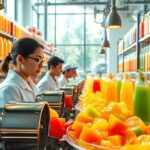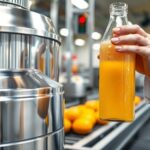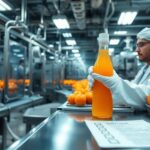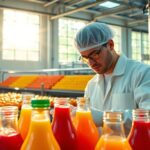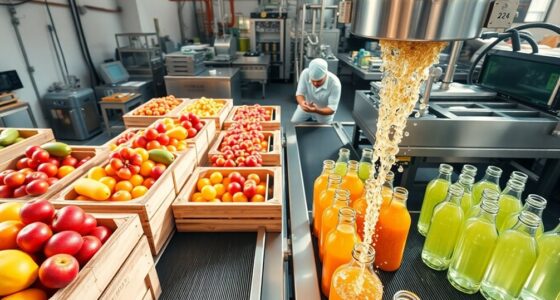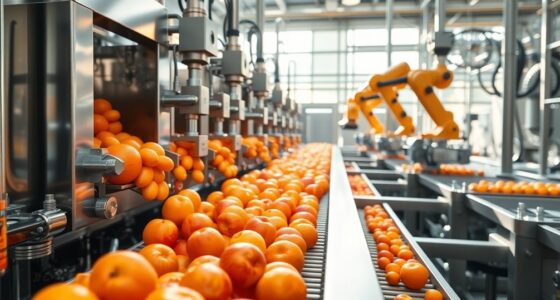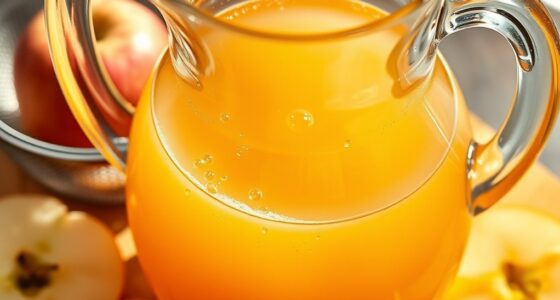To achieve production perfection in juice processing, focus on selecting fresh, quality raw materials and establish strong supplier partnerships. Implement effective sanitation and hygiene practices to guarantee product integrity. Embrace advanced extraction techniques like cold-pressing and High-Pressure Processing (HPP) to boost yield while minimizing waste. Utilize sustainable packaging solutions to attract eco-conscious consumers. By mastering these practices, you can optimize operations and enhance product quality. Stick around to uncover more insights into successful juice production!
Key Takeaways
- Select high-quality, fresh, and ripe fruits and vegetables to enhance flavor and yield in juice production.
- Implement regular cleaning schedules and staff training on hygiene practices to prevent contamination.
- Utilize advanced extraction methods like cold-pressing and High-Pressure Processing (HPP) to maximize juice yield and preserve nutrients.
- Adopt sustainable packaging solutions to minimize waste and attract environmentally-conscious consumers.
- Conduct routine quality checks and audits to ensure compliance with sanitation protocols and maintain product integrity.
Understanding the Juice Production Market
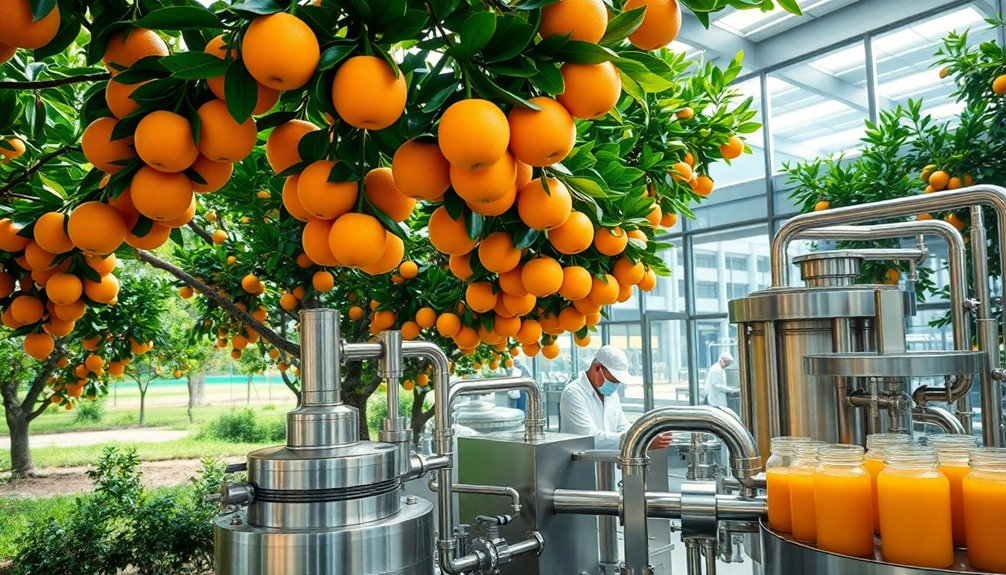
As the global juice market continues to expand, understanding its dynamics becomes essential for producers and investors alike.
The revenue in the global juices segment is projected to hit approximately $116.80 billion in 2023, reflecting a strong demand for juice products.
Significantly, in the U.S., sales of fruit juice drinks surged from 694 million cases in 2014 to nearly 1.4 billion by 2021, indicating a clear trend toward increased consumption.
The juice production process plays a critical role in meeting this demand, as the industry produced around 230,000 metric tons at 65 degrees Brix in the 2020/21 season.
With juice production growing faster than the broader manufacturing sector, understanding market dynamics is essential for success. Additionally, beet juice is gaining popularity for its health benefits, particularly in enhancing blood flow and supporting overall wellness.
Selecting Quality Raw Materials
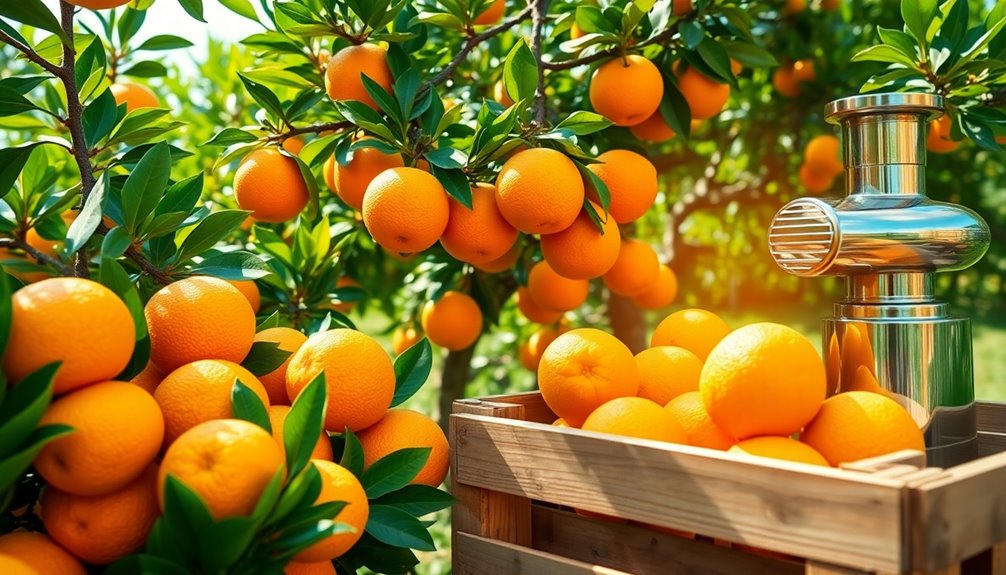
When it comes to juice production, choosing high-quality raw materials is essential for achieving the best flavor and yield. Start by selecting fresh, ripe fruits and vegetables that meet your quality standards.
Establish partnerships with reliable suppliers to maintain consistent supply chains, guaranteeing a steady flow of premium ingredients. Upon delivery, conduct thorough inspections to assess quality and freshness, as this directly impacts your final product.
Stay aware of seasonal availability to adjust your sourcing strategies, maximizing quality while minimizing costs. Moreover, ascertain traceability of raw materials from farm to production. This not only helps with quality control but also allows you to address any potential issues in your supply chain effectively. Regularly conduct quality control tests on raw materials to ensure safety and maintain the integrity of your juice.
Implementing Effective Sanitation and Hygiene Practices

To guarantee your juice production maintains the highest quality, implementing effective sanitation and hygiene practices is non-negotiable.
A clean environment prevents contamination and guarantees your product's integrity. Here are four key practices to focus on:
- Regular Cleaning Schedules: Establish and adhere to routine cleaning for equipment and facilities.
- Staff Training: Educate your team on proper hygiene practices and the importance of protective gear.
- Routine Audits: Conduct audits to guarantee compliance and identify potential hygiene issues before they impact quality.
- Appropriate Sanitizing Agents: Use the right sanitizers for different surfaces to maintain a safe production environment.
Exploring Extraction and Processing Techniques

When you focus on efficient extraction methods like cold-pressing and centrifugation, you maximize juice yield while keeping nutrients intact.
It's essential to monitor factors like temperature and pressure to minimize oxidation and guarantee high-quality results.
Plus, regular maintenance of your extraction equipment is key to maintaining consistent performance and reducing downtime. Additionally, incorporating organic fruits and vegetables into your juice production can enhance flavor and nutritional value.
Efficient Extraction Methods
Efficient extraction methods play an essential role in maximizing juice yield while preserving the freshness and nutritional value of the produce.
To achieve superior results, consider these key techniques:
- Cold-Pressing: This method uses low temperatures to extract juice, maintaining flavor and nutrients.
- Centrifugation: By spinning the produce at high speeds, you can separate juice efficiently while reducing waste.
- Regular Maintenance: Keep your extraction equipment calibrated to guarantee peak performance and efficiency.
- Monitor Parameters: Keep an eye on temperature and pressure during extraction to uphold consistent quality.
Minimizing Oxidation Exposure
After exploring efficient extraction methods, it's clear that minimizing oxidation exposure is essential for preserving the quality of juice.
In the juice industry, techniques like cold-pressing and centrifugation play a critical role in reducing oxidation during production. By carefully monitoring processing parameters such as temperature and pressure, you can greatly lower the risk of oxidation, which otherwise compromises freshness and nutritional value.
Utilizing vacuum extraction minimizes oxygen exposure, helping maintain vibrant color, flavor, and health benefits. Additionally, specialized packaging that limits oxygen transmission can further protect your juice, extending its shelf life.
Regular maintenance and calibration of your extraction equipment are also important to guarantee peak performance and minimize oxidation-related quality issues. Furthermore, incorporating omega-3 content from sources like chia seeds can enhance the nutritional profile of your juice products.
Equipment Maintenance Importance
To guarantee ideal juice quality and equipment longevity, regular maintenance of extraction and processing machinery is essential.
By focusing on equipment maintenance, you can assure peak performance and prevent costly breakdowns.
Here are four key maintenance practices to implement:
- Clean press bags regularly and check for fiber buildup to prevent contamination.
- Replace worn parts immediately to avoid inefficiencies that can hurt juice yield and quality.
- Inspect blade conditions and adjust speed settings based on the hardness of the produce for maximum extraction efficiency.
- Document maintenance activities to track performance and identify potential issues early.
Prioritizing these steps will keep your juice production process running smoothly and enhance the overall quality of your products. Additionally, regular maintenance is crucial for equipment longevity, as it can significantly affect air quality indicators and overall performance.
The Role of Quality Control in Juice Production

Quality control plays an essential role in juice production, as it secures that every bottle meets the highest standards for safety and taste. Implementing quality checks at various stages guarantees that products pass key parameters like acidity, sugar content, and microbiological safety. This not only maintains product integrity but also builds your brand's reputation. Regular audits further verify compliance with sanitation protocols, while documentation of quality control results enhances traceability. Additionally, using fresh ingredients can significantly improve both flavor and nutritional value in your final product.
| Quality Check | Frequency | Importance |
|---|---|---|
| Acidity Testing | Daily | Secures flavor consistency |
| Sugar Content Measurement | Weekly | Maintains sweetness levels |
| Microbiological Safety | Batch-wise | Secures consumer safety |
| Sanitation Audits | Monthly | Verifies cleanliness |
| Documentation Review | Quarterly | Secures regulatory compliance |
Sustainable Packaging Solutions

When you think about sustainable packaging for juice, consider eco-friendly materials that keep your product fresh while minimizing environmental impact.
Innovative design strategies, like plant-based containers, can attract eco-conscious consumers and enhance your brand's reputation.
Eco-Friendly Material Choices
As the demand for sustainable products grows, opting for eco-friendly packaging solutions in juice production becomes imperative. By making these choices, you can enhance your brand's reputation while minimizing environmental impact.
Here are four key benefits of sustainable packaging:
- Reduced Waste: Using biodegradable plastics and recycled materials minimizes landfill contributions.
- Lower Carbon Footprint: Lightweight and recyclable packaging leads to fewer transportation emissions.
- Consumer Appeal: Compostable options attract environmentally-conscious customers, boosting marketability.
- Circular Economy: Sustainable sourcing practices reduce reliance on fossil fuels and promote renewable resources.
Incorporating these eco-friendly material choices into your supply chain management not only supports sustainability but also streamlines the production process, ensuring a more efficient operation overall. Additionally, implementing practices such as organic seed cultivation can further enhance the sustainability of your product ingredients, contributing to a more eco-conscious brand image.
Innovative Design Strategies
Innovative design strategies in sustainable packaging can transform the juice production landscape, making it more efficient and eco-friendly. By utilizing biodegradable materials derived from plants, you can reduce reliance on petroleum-based plastics while minimizing environmental impact.
Lightweight designs not only cut transportation costs but also lower carbon emissions, aligning with your sustainability goals. Incorporating recyclable materials supports a circular economy, appealing to eco-conscious consumers.
Concentrated juice packaging can further decrease the volume of packaging needed, enhancing shelf life and reducing waste. Plus, smart packaging technologies like QR codes engage consumers and provide recycling instructions, encouraging responsible disposal practices. Additionally, using packaging that preserves nutritional value can help ensure that consumers receive the full benefits of the juice they purchase.
These strategies not only boost your brand's image but also contribute to a healthier planet.
Waste Reduction Techniques
Sustainable packaging solutions play an essential role in waste reduction techniques, helping you minimize the environmental impact of juice production.
By adopting these practices, you can effectively manage sugar content while enhancing your brand's appeal. Here are four key strategies to contemplate:
- Biodegradable Materials: Use packaging that breaks down naturally, reducing landfill waste.
- Recyclable Containers: Opt for materials that customers can easily recycle, promoting a circular economy.
- Lightweight Designs: Minimize material usage, cutting both waste and transportation costs.
- Innovative Technologies: Implement vacuum-sealing or modified atmosphere packaging to extend shelf life and reduce food waste.
Additionally, embracing sustainable practices in packaging can align your production methods with broader environmental goals, further enhancing your brand's commitment to green living.
Advanced Processing Methods: HPP, Hot-Fill, and Aseptic

Juice production relies heavily on advanced processing methods like High-Pressure Processing (HPP), Hot-Fill, and Aseptic techniques to enhance product safety and extend shelf life.
HPP is a cold pasteurization method that effectively eliminates bacteria while preserving juice's health benefits, though it requires heavy-duty containers.
On the other hand, Hot-Fill Processing heats juice to kill bacteria and provides a shelf life of 6 to 12 months, allowing for creative bottle designs.
Aseptic Processing fills bottles at room temperature under sterile conditions, offering up to 18 months of shelf life without refrigeration.
Each of these advanced processing methods considerably impacts production efficiency, cost, and overall stability, making the right choice essential for success in the competitive juice market.
Maximizing Juice Yield With Best Practices

To maximize juice yield, incorporating best practices in the production process is key. By following these methods, you can considerably enhance your juice extraction results:
- Mix Different Produce: Combining various types can boost your yield by about 7% by keeping juice channels open.
- Monitor Water Content: Use fruits and vegetables with higher hydration levels for better extraction.
- Refine Shredder Settings: Experiment with shredder speeds and blade sizes; softer produce benefits from slower speeds and larger blades.
- Maintain Equipment: Regularly clean press bags and inspect worn parts to guarantee peak performance.
Implementing these best practices won't only improve your juice yield but also enhance the overall quality of your products.
Leveraging Technology for Production Optimization
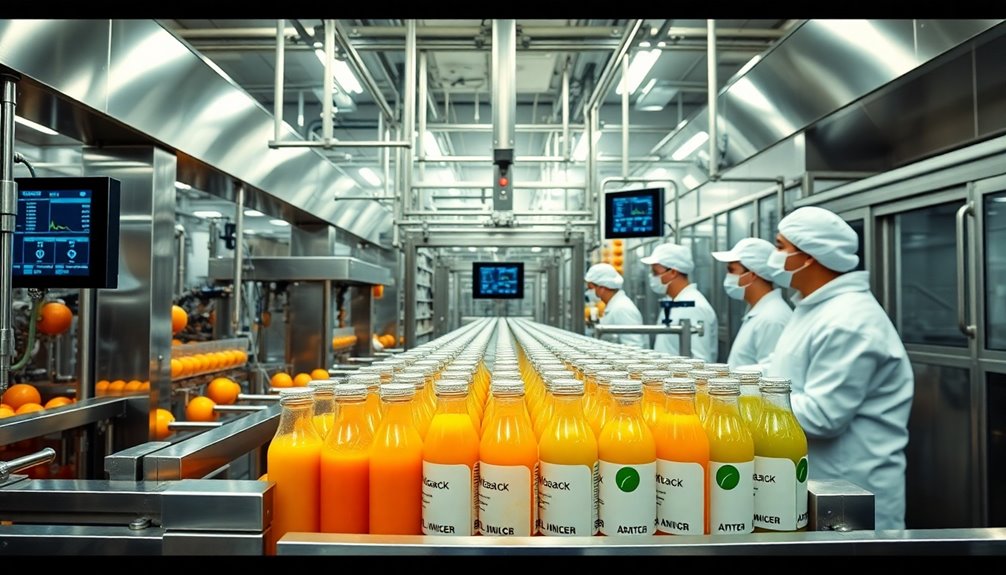
As you explore ways to optimize production, leveraging technology can greatly enhance efficiency and product quality.
Implementing advanced extraction methods, like cold-pressing and centrifugation, boosts juice yield while preserving nutrition.
Utilizing Acumatica ERP systems gives you real-time visibility into inventory and production schedules, streamlining resource use and minimizing bottlenecks.
Regular testing through statistical process control techniques helps monitor quality, allowing you to quickly address any deviations.
Automating pasteurization and blending reduces human error, improving operational performance and safety.
Additionally, adopting lean manufacturing methodologies, such as Value Stream Mapping, helps identify and eliminate waste, ultimately enhancing productivity and cutting costs.
Embrace these technologies to guarantee your juice production process runs smoothly and efficiently. By implementing state-of-the-art equipment and automation systems, you can enhance productivity and minimize waste. These advancements are particularly beneficial during the commercial juice production phases, where precision and consistency are key to meeting consumer demands. Additionally, investing in quality control technologies ensures that every batch meets the highest standards, leading to increased customer satisfaction and brand loyalty.
Frequently Asked Questions
What Are the Steps of Juice Production?
To produce juice, you start by selecting high-quality fruits or vegetables, then wash and sort them to remove dirt and damaged pieces.
Next, you extract the juice through pressing or crushing, followed by filtration to achieve a smooth consistency.
After that, pasteurization guarantees safety by heating the juice.
You might blend different batches for consistency, and finally, package the juice in sterilized containers, labeling them accurately for quality and safety before distribution.
What Are the Basic Principles of Juice Extraction?
Did you know that mixing different fruits can boost your juice yield by about 7%?
When you're extracting juice, start by selecting ripe, high-quality produce. You'll want to wash and sort it carefully to remove dirt and damage.
Choose an extraction method—like pressing or grinding—that suits your needs.
After extraction, don't forget to filter out pulp and seeds for that smooth consistency.
These principles will guarantee your juice is both flavorful and appealing!
What Is the Processing at the Juice Packer?
When you consider the processing at the juice packer, you'll find several key steps.
First, fruits and vegetables are washed, sorted, and prepared.
Then, the juice is extracted and pasteurized to eliminate harmful microbes.
Throughout this process, quality control checks guarantee the juice meets standards for taste and safety.
Finally, the juice is packaged in sterilized containers, with technologies like Lean and Six Sigma optimizing efficiency and minimizing waste.
What Is the Best Way for an Approved Source to Reduce the Number of Harmful Microorganisms in Pre-Packaged Juice?
When it comes to reducing harmful microorganisms in pre-packaged juice, you've got to strike while the iron's hot.
Implementing High Pressure Processing (HPP) can effectively eliminate these threats while keeping your juice fresh and nutritious.
Hot-Fill Processing is another cost-effective method that extends shelf life.
Don't forget to maintain strict sanitation protocols and conduct regular quality control testing to guarantee your product stays safe and compliant throughout the production process.
Conclusion
In the whirlwind world of juice production, mastering these practices isn't just essential—it's your golden ticket to success! Imagine transforming your operation into a juice powerhouse that dazzles consumers and crushes the competition. By embracing quality, sustainability, and cutting-edge technology, you're not just producing juice; you're creating liquid gold that flows with flavor and freshness. Don't just settle for good; aim for perfection and watch your business soar to unimaginable heights!
Cindy thoroughly researches juicing trends, techniques, and recipes to provide readers with practical advice and inspiration. Her writing style is accessible, engaging, and designed to make complex concepts easy to understand. Cindy’s dedication to promoting the advantages of juicing shines through her work, empowering readers to make positive changes in their lives through the simple act of juicing.




